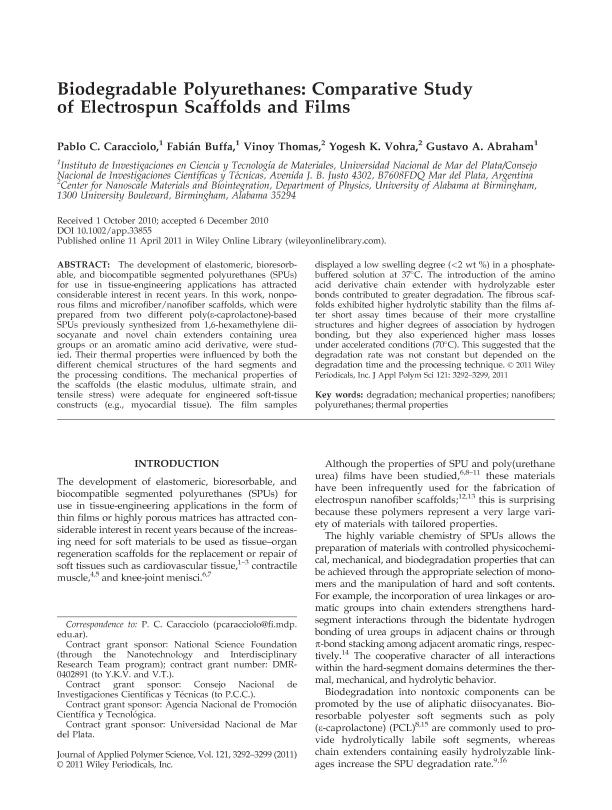Artículo
Biodegradable polyurethanes: Comparative study of electrospun scaffolds and films
Caracciolo, Pablo Christian ; Buffa, Juan Manuel
; Buffa, Juan Manuel ; Thomas, Vinoy; Vohra, Yogesh K.; Abraham, Gustavo Abel
; Thomas, Vinoy; Vohra, Yogesh K.; Abraham, Gustavo Abel
 ; Buffa, Juan Manuel
; Buffa, Juan Manuel ; Thomas, Vinoy; Vohra, Yogesh K.; Abraham, Gustavo Abel
; Thomas, Vinoy; Vohra, Yogesh K.; Abraham, Gustavo Abel
Fecha de publicación:
09/2011
Editorial:
Wiley
Revista:
Journal Of Applied Polymer Science
ISSN:
0021-8995
Idioma:
Inglés
Tipo de recurso:
Artículo publicado
Clasificación temática:
Resumen
The development of elastomeric bioresorbable and biocompatible segmented polyurethanes (SPU) for use in tissue engineering applications has been a subject of considerable interest in recent years. In this work, non-porous films and micro/nanofibrous scaffolds prepared from two different poly(ε-caprolactone)-based SPU previously synthesized using 1,6-hexamethylene diisocyanate and novel chain extenders containing urea groups or an aromatic aminoacid derivative, were studied. Thermal properties were influenced both by the different chemical structure of the hard segments and the processing conditions. Mechanical properties of the scaffolds showed elastic moludus, ultimate strain and tensile stress values adecuate for soft-tissue engineered constructs (i.e.: myocardial tissue). Film samples displayed low swelling degree (less than 2 wt %) in phosphate-buffered solution (PBS) at 37 ºC. The introduction of the aminoacid derivative chain extender with hydrolyzable ester bonds contributed to a higher degradation. Fibrous scaffolds exhibited higher hydrolytic stability than films at short times of assay, due to their more crystalline structures and higher degrees of association by hydrogen bonding, but also higher mass loss values in accelerated conditions (70 ºC), suggesting that degradation rate is not constant but depends on the degradation time and the processing technique.
Archivos asociados
Licencia
Identificadores
Colecciones
Articulos(INTEMA)
Articulos de INST.DE INV.EN CIENCIA Y TECNOL.MATERIALES (I)
Articulos de INST.DE INV.EN CIENCIA Y TECNOL.MATERIALES (I)
Citación
Caracciolo, Pablo Christian; Buffa, Juan Manuel; Thomas, Vinoy; Vohra, Yogesh K.; Abraham, Gustavo Abel; Biodegradable polyurethanes: Comparative study of electrospun scaffolds and films; Wiley; Journal Of Applied Polymer Science; 121; 6; 9-2011; 3292-3299
Compartir
Altmétricas



